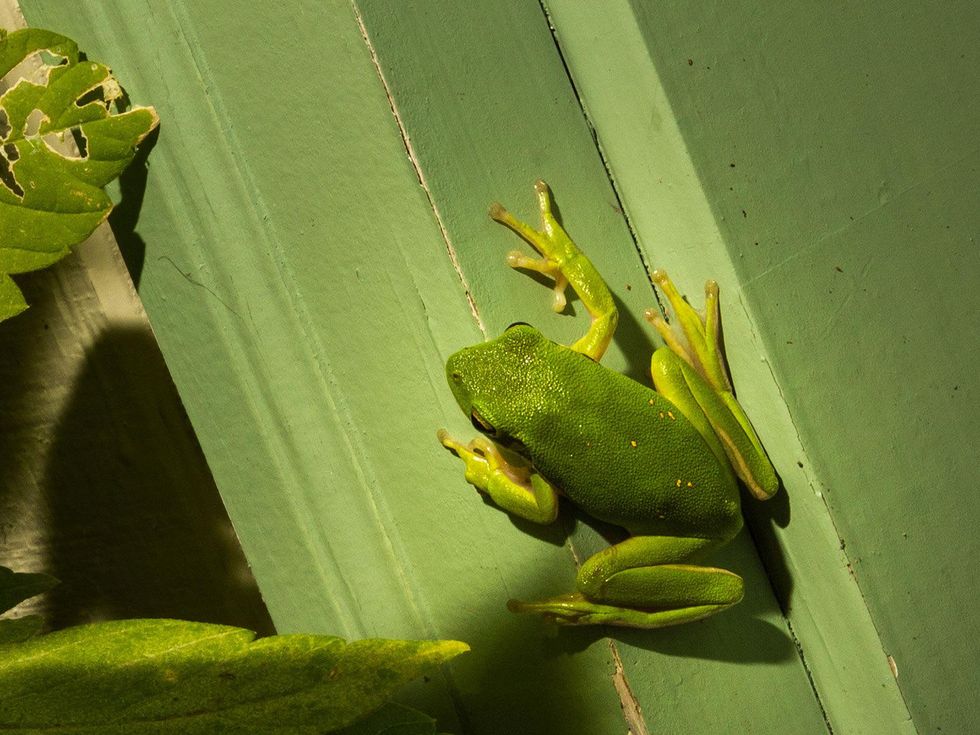The Farmer Diaries
Drought-relieving rain puts Texas gardens back on track in more ways than one
Aside from carrots, I've planted nothing outdoors so far: no cucumbers, beets, Swiss chard or anything else I'd normally have sown by now. Snow in early March and steady rain since has made the soil soggy and unworkable.
However, I feel optimistic about the 2015 growing season, because the precipitation this year has several benefits that will offset any delay it has caused.
Soil moisture recharge
Slow and steady, the precipitation this year has been different from recent years, when quick showers drenched everything, flooding parking lots and overflowing creeks but doing little to saturate the soil.
Counter to common sense, dry soil does not soak up moisture; it repels it, similar to the way cocoa powder opposes being wetted, requiring time before it finally accepts moisture. For this reason, a downpour does almost nothing for trees, lawns and gardens.
I became aware of how moisture-resistant dry soil can be from a video project I worked on for a client, showing how the equivalent of a heavy downpour can take nearly an hour to work its way into the dirt.
Four inches of water will reach down about six to eight inches into the ground, leaving the soil below as dry as it would have been with no rain at all. Of course, that's if the water has time to sit and percolate. Most yards, even most fields, are inclined toward a ditch or a creek to some degree, causing heavy rainfall to run off before it has time to be absorbed.
The pattern this year, with snowfall in February and early March, gave us a trickling form of moisture replenishment once it began to melt. The continuing light rainfall that followed compounded the benefits, allowing water to penetrate deep into our drought-stricken soils. The fact that the creeks near the land where I farm have only slightly filled, even after what's been almost nonstop rain for the two weeks, demonstrates our soils are indeed recharging.
Nitrogen release
Ample rainfall feeds the soil microbes that convert the nitrogen in organic matter into a form that plants can use. The process is called mineralization, and as long as the soil does not become wholly saturated but remains well aerated, this nitrogen will benefit crops just as if it were added as a fertilizer.
Also, precipitation carries nitrogen in the form of nitrate from the atmosphere into the soil. The N in an N-P-K reading of a synthetic fertilizer stands for nitrogen; rainfall is an abundant source of this plant nutrient, free of charge.
Rainwater collection
For everyone collecting rainwater, the abundant precipitation this year has filled up even the largest rainwater harvesting setups. The 17,000-gallon system of tanks my father connected to the gutters of a building near the field crops is at capacity. They're now overflowing into a large, blue stock tank that looks like an above-ground swimming pool.
Several rain barrels I've placed under the eave of my house have also filled up and will keep my container-grown plants well water until June, even if the rains cease. Rainwater exceeds tap water in helping plants to grow strong and healthy, and we have plenty of it for a while.
Toads, lizards, skunks and birds
Because every nearby pond has once again filled with water, the wildlife population has what it needs to rebound this year.
Last year, as the Texas drought continued to take a toll on plants and animals, wildlife on the farm became scarce. My resident skunks seemed to pack up and find better accommodations elsewhere. A road runner that had lived onsite for three years fled. Toads were almost nonexistent after June.
The result of this animal dearth is twofold: First, I have fewer animals to enjoy the companionship of. Second, pests have no predators to keep their numbers down. If the rain this year brings my animal colleagues back, I should have a growing season that's a close to grasshopper-free as it can get.





 Bouldin Creek Cafe's sweet and savory oven cake breakfast. Photo from Bouldin Creek Cafe Facebook
Bouldin Creek Cafe's sweet and savory oven cake breakfast. Photo from Bouldin Creek Cafe Facebook Ramen Tatsu-ya has plenty of options for chilly days, but you can't go wrong with the OG Tonkotsu. Photo from Ramen Tatsu-ya Facebook
Ramen Tatsu-ya has plenty of options for chilly days, but you can't go wrong with the OG Tonkotsu. Photo from Ramen Tatsu-ya Facebook The matzoh ball Soup at Mum Foods, a barbecue and delicatessen combo. Photo from Mum Foods Smokehouse and Delicatessen Facebook
The matzoh ball Soup at Mum Foods, a barbecue and delicatessen combo. Photo from Mum Foods Smokehouse and Delicatessen Facebook La Barbecue's smoky brisket chili for a cozy winter day.Photo from La Barbecue Facebook
La Barbecue's smoky brisket chili for a cozy winter day.Photo from La Barbecue Facebook